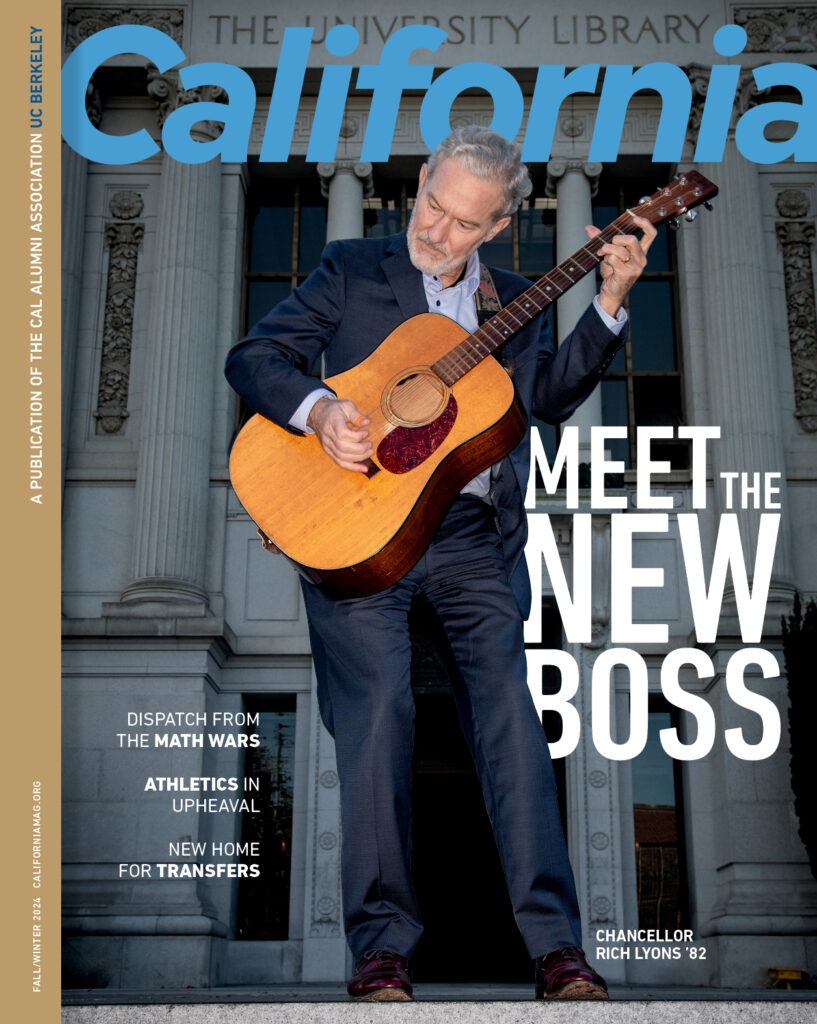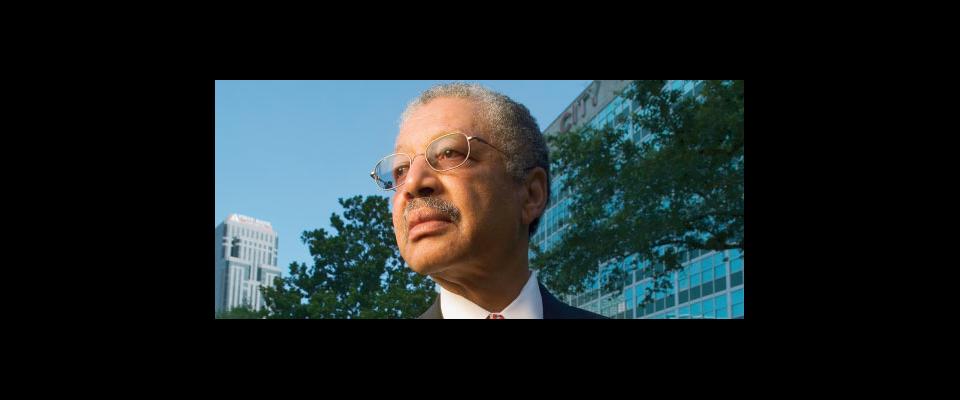Former Berkeley Professor Edward J. Blakely brings order to New Orleans’s hodgepodge bureaucracy, and urgency to its laissez-faire citizenry.
It was just past seven on a balmy Tuesday morning last February, and the streets of New Orleans’s moribund Central City were temporarily bustling. Barbecues hissed as hip-hop throbbed from car stereos and the open windows of seemingly abandoned homes. Residents displaced to Houston, Atlanta, and Baton Rouge had returned, filling vacant lots with folding chairs, card tables covered with floral cloths, and coolers. They’d come to witness the Mardi Gras return—after a one-year, post-Katrina hiatus—of the Zulu Social Aid and Pleasure Club. Founded in 1909 to provide African-American residents with insurance, the benevolent society is now known primarily for sponsoring Fat Tuesday’s largest and most famous African-American parade.
At La Maison, a wood-frame house built in the mid-1800s and more recently converted into apartments, the celebration was in full swing. Partygoers ducked through a second-story window to a balcony overlooking the parade route through the old working-class neighborhood. Their host was tenant Edward J. Blakely, a soft-spoken urban planner and former Berkeley professor who had arrived in January to take on the professional challenge of a lifetime: orchestrating the city’s belated post-hurricane rebirth. Before long the parade began, with New Orleans Mayor Ray Nagin in the lead astride a chestnut mare. Nagin spotted Blakely and beamed. When announcing Blakely’s hire in December 2006, Nagin could not have been more bullish, declaring, “We think he’s the best in the world to help us get through this recovery.”
Blakely’s bona fides testify for his selection. He rose from an impoverished childhood in San Bernardino to earn a master’s degree at Berkeley and a doctorate at UCLA . His 40-plus years of experience include advising governments in Korea, Japan, South Africa, and Europe, as well as two Oakland mayors; authoring or coauthoring four books; and chairing Berkeley’s Department of City and Regional Planning. He has served as a dean at urban planning departments at The New School University in New York City and the University of Southern California. He currently chairs the Urban and Regional Planning program at the University of Sydney while heading a team studying urban climate change and global warming for the Lincoln Institute of Land Policy, a think tank based in Cambridge, Massachusetts.
And yet one of Blakely’s strongest assets may have been pronounced in his early assessment of the challenge of putting the Big Easy back together: “There are forces here that would rather have failure than success.” His trademark piercing candor, interpreted by some as the hubris of an outsider, is something that narcissistic New Orleans has rarely tolerated in the past.
Nagin’s parade horse trotted off, and the “Province Prince” appeared. A two-tiered float fronted by a massive statue of a feather-clad warrior, it embodied a Zulu tradition that began as a counter to the exclusively white parades and evolved (some say devolved) into a spectacle of campy ethnic stereotypes. As the float trundled past, Zulus on board decked out in blackface and afro wigs hurled doubloons, beads, spears, footballs, and rubber snakes at the outstretched hands of the surging crowd.
One by one, Blakely’s guests slipped down to the street, but Blakely had no interest in flying prizes or any other aspect of the parade. “Not my kind of thing,” he said.
The Mardi-Gras-at-any-price mentality is just one of many hurdles confronting Blakely as he tries to refashion the city known more for great beignets than for good business sense. Other challenges include the precarious state of the levees, floundering schools, a resurgence of gun violence in the streets, and the drifting homeward of unemployed, homeless residents. There is an intractable, impossibly diffuse, and dysfunctional local government bureaucracy; a culture of pervasive corruption that has left the city with zero Wall Street credibility; and the issue of race—or, more precisely, racial politics—which may be the biggest barrier to the city’s recovery.
African Americans make up the largest percentage of residents who have not moved back to the city. The more affluent white neighborhoods along the Mississippi River that suffered mild hurricane and flood damage (the so-called Sliver by the River) are largely revived, while some predominantly African-American neighborhoods that were all but destroyed remain mostly empty. This disparity has intensified an already sharp racial divide. Blakely, who like the mayor is African American, is frequently sought out by residents looking for a champion. “We get people saying ‘we want you to deal with the race issue, the schools,'” Blakely said. “Every problem the city has, they suddenly want me to fix.”
But Blakely frequently reminds residents and city leaders that his job, simply put, is to generate revenue and build momentum for new housing and businesses, to get the work going, and to show the city how to keep it going when he leaves.
When it comes to specific goals, Blakely is evasive. He won’t say what, precisely, he intends to accomplish before he departs, or when, for that matter, he plans to take his leave. He has suggested variously that he will leave within a year, that he will be done when the mayor says he is, or when the people say he is, or when he can’t get access to the funding needed to keep his projects moving. Such responses acknowledge the perils of speaking with certainty about a future that is anything but clear. Since August 2005, when 480 billion gallons of water poured into New Orleans, covering 80 percent of the city and festering for weeks, more than 1,400 Louisiana residents have died as a result of Katrina. As of Mardi Gras 2007, much of the city that was damaged or destroyed was still in ruins. More than 200,000 New Orleansians remained displaced, and the city was operating with half its pre-Katrina budget and staff. The total cost of the disaster approached $250 billion. None of this was news to Blakely when he arrived. But after six weeks on the job, he was beginning to grasp the profound depth of the city’s need. As he stepped away from the parade and brewed a fresh pot of coffee, he reflected, “It’s like nothing I’ve ever done before.”
Yet the magnitude of the mess is what appeals to him. As executive director of the New Orleans Office of Recovery Management, Blakely’s goal is to amass enough funding to build large-scale housing and commercial developments that target specific high-visibility, high-impact areas. He has identified 17 zones for various degrees of redevelopment. The work ahead includes an overhaul of the devastated African-American community known as the Lower Ninth Ward, to include housing, commercial centers, schools, and community centers. Other projects range from an 80-acre regional, mixed-use residential, shopping, and hotel complex in New Orleans East, to a facelift for a modestly damaged commercial strip in Village de l’Est, the Vietnamese community on the eastern edge of the city. Smaller projects are scattered across the remainder of the incorporated area.
Initially Blakely had expected work to begin in September 2007, but by early summer he acknowledged that it was taking longer than he expected to raise the estimated $1.1 billion required to move forward. That funding includes hundreds of millions of dollars in federal disaster relief that must be wrested from competing recovery programs, as well as a sizable chunk that must be appropriated from recent city bond issues. Blakely remains confident that he can pull the money together and that the work will be underway by yearend. Once these “seed” projects are off the ground, Blakely’s theory goes, they will boost public confidence and lead to private investment, which will lead to even more private investment and more development. Combine this “spread effect,” as Blakely calls it, with the ongoing work of his agency, and the city will be on its way back.
A realist with an outsider’s advantage, Blakely has heard the arguments that location-wise, at the bottom of the Mississippi Delta, New Orleans is a geographic mistake that should not be repeated and hence not rebuilt. His response is that the city should be rebuilt, but rebuilt better. So he walks the line between the ennui that holds sway over so much of city life, and the seriousness of his mission. “The level of stress here is so low it destroys the possibility of doing good things,” he said, his bespectacled demeanor softened somewhat by drooping eyelids and a neatly trimmed salt-and-pepper moustache complementing his equally neatly trimmed hair. “I just have to keep it in mind.”
Planner-speak can be as mind dulling as any specialized language, but Blakely has a knack for conveying his ideas in quick, often witty bites. During his early months in New Orleans, he has shopped aspects of his still-evolving plan to city council members and agency heads, to foundation boards and businesspeople, to college committees and community groups, as well as to the media. When explaining the importance of reducing the city’s reliance on tourism, because the jobs it generates are mainly low-wage, he said, “We’ve got to stop selling T-shirts.” When outlining his plan to woo lucrative new industries such as a biomedical center that would develop products and services for export to Latin America, he said, “It’s not the beds that count, it’s the biomedicine.”
Blakely, 69, takes a scavenger’s delight in finding new value in the city’s neglected resources. He’s working to boost shipping through the city’s underutilized port (“We were the biggest port in the Gulf and we went to sleep on our assets.”), and he’s pushing for expanded cargo service at the eerily empty airport (“We’re not carrying enough freight—that’s where the real money is these days.”). When Blakely learned that the city loses half the water it pumps each day because of massive leaks in the municipal sewer system, he saw opportunity. Why couldn’t the city fix the leaks, capture that surplus and turn it into a commodity instead? And he wants shuttered housing projects repaired and reopened for 1,000 workers immediately, with a companion training program.
While singularly focused on putting the pieces in place to begin redevelopment, Blakely is not forging ahead in a vacuum. He’s incorporating locally developed plans into his strategy, most notably the Unified New Orleans Plan, a $5.5 million proposal more than a year in the making that combines the work of dozens of government agencies and community groups. In the end, though, the plan he comes up with must satisfy his own vision for the city. “If you haven’t built a city, you might want to listen,” he challenges. “I’m not bashful about that.”
“This is the biggest and most challenging reconstruction since the 1906 San Francisco Earthquake,” said Gary Hack, dean of the University of Pennsylvania School of Design and member of the winning redevelopment design team for the World Trade Center in New York. A big part of that challenge for Blakely is being an outsider in the consummate insider’s town. He refuses to partake in the good-old-boy approach, preferring to build his own networks in his own way. He golfs, plays tennis, bikes, and is a vegetarian, retaining the athletic physique of the erstwhile college quarterback who captained his UC Riverside team to an undefeated season (he was named Athlete of the Year in 1959 and later inducted into the university’s Hall of Fame).
A wealthy man by virtue of a sustainable living community he helped develop in Southern California, Blakely said he initially refused the $150,000 annual salary for the New Orleans job, but Nagin insisted. “He wanted to hold me accountable,” Blakely said. “He felt that by paying me I would feel more bound to the city.”
Rule number one in the Blakely book of leadership—if such a thing existed—might be Act like you’re the boss. Blakely refers to himself as New Orleans’s renewal “coach” and asked a city council member who was formerly with the New Orleans Saints NFL team to arrange a photo op with the team during summer training. The message: “I’m here rebuilding the city and here rebuilding the team.” During a January press conference, he and his 17-member staff appeared in matching purple polo shirts embellished with gold fleurs de lis (the logo of the New Orleans Saints football team).
For New Orleans, Blakely’s methods are unprecedented. For Blakely, it’s a familiar role, one that enables him to meld erudition and the real-world chops he’s honed for years. While at Berkeley, he worked long and steadily in the redevelopment of Oakland and aided in the city’s recovery from the Loma Prieta earthquake in 1989 and the Oakland Hills firestorm of 1991.
One has to wonder, though, in a city where power is cultivated through long-term personal relationships, whether Blakely has any real clout. Does anyone have to listen to what he says? The short answer is no, and Blakely is the first to acknowledge it. “It’s like a doctor,” he reasons. “You’ve got your patients. You hope they’ll do the right thing. If they don’t, there’s nothing you can do about it.”
The experience that probably best prepared Blakely for the sort of power-leveraging he needs in New Orleans was his tenure, post 9/11, on a citizen’s advocacy panel called the Civic Alliance to Rebuild Downtown New York. As a co-chair, Blakely had a hand in nearly all the alliance’s accomplishments, said Robert D. Yaro, chair of the alliance and president of the area’s Regional Plan Association. A week after the terrorist attacks, when government agencies were swamped with disaster recovery, Yaro, Blakely and several others devised a $5 billion downtown transportation proposal that is now under construction. Later, Blakely took a lead role in quashing a developer’s plan to site a suburban-style shopping mall at Ground Zero, helping to persuade the Port Authority to buy out the lease for $400 million. And Blakely helped secure and dole out millions of dollars in community redevelopment funds in the area. “Ed is the consummate professional,” Yaro said. “He brings an authority and integrity to the process that is above the fray. We needed that in New York after 9/11, and New Orleans needs rogram.”
When Blakely arrived in New Orleans in January, his City Hall office consisted of an empty, fluorescent-lit room furnished solely with 17 straight-backed chairs, one for each member of his staff. No matter. He didn’t spend much time there anyway. He led neighborhood bicycle rides to meet with residents and community groups and seek input for his plan. He weighed in on renewal at every opportunity, openly criticizing programs that didn’t work.
Regarding state and federal aid, he told business leaders, “We are … not going to kiss anybody’s ring—or any other part of the anatomy,” and said he would help the city generate investments from private sources. When a television reporter asked Blakely if he would incorporate green space into redevelopment projects to guard against future flooding, he replied: “What I’d like to see … is spaces that produce green dollars. … It’s a lot better to have a small factory knocking down a surge than a blade of grass.” In Blakely’s first meeting with the state-run Louisiana Recovery Authority, when the body wavered over granting his request for control of a $117 million infrastructure fund, his response was unequivocal. “If I don’t have it, I go home,” he said. The agency acquiesced.
At times Blakely’s impatience crosses the line into snobbery, particularly when his verbal barbs veer away from the politics of the city to its people. He noted that the city pumped $100 million into this year’s Mardi Gras while blighted homes and piles of debris still dominated neighborhoods. He concedes that trying to stop Mardi Gras “would be foolish,” because “there’s something too deeply ingrained in the culture not to spend the money. But would I invest a lot of time and money in it? No.”
But by assuming responsibility rather than dodging blame or public outcry over his perceived insults, Blakely has won the support of city leaders as he sells them on the transformative effect a good urban plan can have on wideranging city woes. For New Orleans he devised a five-point recovery strategy that reads more like a wishful cure-all: Continue the healing and consultation; improve safety and security in all communities; develop a more diverse and robust economy; build an infrastructure for the 21st and 22nd centuries; and establish a smart and sustainable settlement pattern. Blakely sees these points more as guiding principles than concrete goals—a way of trying to shape and manage the fast-moving, scattershot approach that had been driving city development. “This is a train,” he said. “We’re going to be riding on the side of it, but there are things we can do from here to improve it.”
Of course, none of the rebuilding will make any difference if the levees fail. Blakely is as aware of this reality as anyone. “If we have even a small breach on those dikes,” Blakely said, “it’s over.” He is working with the U.S. Army Corps of Engineers on elevation plans and other ways urban design can increase the safety of New Orleans residents. In the short term, he wants to eliminate the “low house/ high house” phenomenon popping up around town. “You’ve got one house up here, another down low,” he said, gesturing. “As soon as the surge comes, the low house just knocks over the high one. It’s like a bowling alley.” But, he said, overall redevelopment in New Orleans can’t wait for an unassailable levee safety guarantee. “If I take all that stuff into consideration I wind up doing nothing,” he said. “I don’t have time for that.”
From the September October 2007 Green Tech issue of California.



















